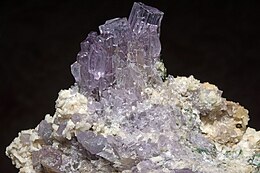| Scapolite group | |
|---|---|
 | |
| General | |
| Category | Tectosilicates |
| IMA symbol | Scp[1] |
| Crystal system | Tetragonal |
| Identification | |
| Color | Pink, red, blue, brown, white, grey, colourless, green, yellow, orange, purple |
| Cleavage | Good, in 2 directions |
| Fracture | Conchoidal, uneven, brittle |
| Mohs scale hardness | 5.5–6 |
| Luster | Vitreous |
| Streak | White |
| Diaphaneity | Opaque to transparent |
| Specific gravity | 2.6–2.74 |
| Optical properties | Uniaxial (–) |
| Refractive index | nω = 1.555–1.594 nε = 1.526–1.565 |
| Birefringence | 0.004–0.038 |
| Pleochroism | Moderate to strong |
| Dispersion | 0.017 |
| Ultraviolet fluorescence | Inert to strong pink, orange and yellow |
The scapolites (Greek: σκάπος, "rod", and λίθος, "stone") are a group of rock-forming silicate minerals composed of aluminium, calcium, and sodium silicate with chlorine, carbonate and sulfate. The two endmembers are meionite (Ca4Al6Si6O24CO3)[2] and marialite (Na4Al3Si9O24Cl).[3][4] Silvialite (Ca,Na)4Al6Si6O24(SO4,CO3) is also a recognized member of the group.[5][4][6]
- ^ Warr, L.N. (2021). "IMA–CNMNC approved mineral symbols". Mineralogical Magazine. 85 (3): 291–320. Bibcode:2021MinM...85..291W. doi:10.1180/mgm.2021.43. S2CID 235729616.
- ^ Meionite data on Webmineral
- ^ Miarialite data on Webmineral
- ^ a b Scapolite group on Mindat.org
- ^ Silvialite data on Webmineral
- ^ Teertstra, D. K.; Schindler, M.; Sherriff, B. L.; Hawthorne, F. C. (1999). "Silvialite, a new sulfate-dominant member of the scapolite group with an Al-Si composition near the 14/m–P42/n phase transition". Mineralogical Magazine. 63 (3): 321–329. Bibcode:1999MinM...63..321T. doi:10.1180/002646199548547. ISSN 0026-461X. S2CID 129588463.